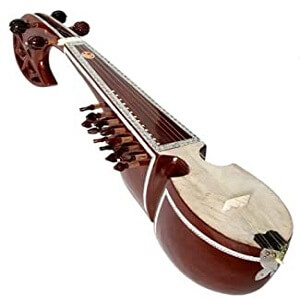Rubab
 Rubab or Rabab was introduced to the Indian classical music scene around the fourteenth and fifteenth centuries. It rose to the zenith of fame in the sixteenth century and remained there as the most popular string instrument along with the rudra veena till the eighteenth century. With the emergence of the sursingar and surbahar in the beginning of the nineteenth century, rabab and rudra veena were marginalised, and after the emergence and popularisation of the sarod and sitar in the twentieth century, both these instruments faded into oblivion.
Rubab or Rabab was introduced to the Indian classical music scene around the fourteenth and fifteenth centuries. It rose to the zenith of fame in the sixteenth century and remained there as the most popular string instrument along with the rudra veena till the eighteenth century. With the emergence of the sursingar and surbahar in the beginning of the nineteenth century, rabab and rudra veena were marginalised, and after the emergence and popularisation of the sarod and sitar in the twentieth century, both these instruments faded into oblivion.
As far as we are aware, the earliest description of a musical instrument termed rabab has been given in the Kitab- al-Musiqi Al Kabir of Al-Farabi (AD 872-950). Al-Farabi says that this rabab is similar to the tanbur of Hurasan, a long- necked lute with a small bulging body, several frets on the fingerboard and two strings of the same thickness, which were plucked by means of a plectrum. Commonly five frets and sometimes more on the tambur of Hurasan were fixed, the others remained movable. This short lute when travelled westwards, became rebec and paved the way for the invention of the violin. The features of this Persian and Arabic rabab are quite similar to the Indian sarangi.
There is another rabab called Afghani rabab or Kabuli rabab, features of which are mentioned as having a small body, and six to seven sympathetic strings. The important thing about this is that this Afghani rabab is plucked instead of bowed. This type of rabab is still prevalent in Kashmir! folk music. Except the Afghani rabab, all the other rababs played outside India are bowed.